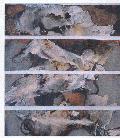|
Some painters prefer to work in an expressionist mode. This is a simple fact.
It is difficult to function expressionistically in today's cool simulationist
art world. Nevertheless, Geiser works this way. His method requires
considerable discipline -- another fact that is sometimes overloooked. There
is the misconception that expressionism is about expressing oneself -- as if
nothing else mattered. Before a painting becomes expressionist, it requires
a motive, an intention, and a clear direction. It requires something from
the artist, a sense of knowing.
Painting -- particularly, abstract gestural painting--is not an image. Here is
another great misconception -- that a painting is synonymous with an image;
but an image is a representation that comes into being only after the painting
has been reproduced photographically. If a painting shows up on a
website then it is an image.
Otherwise, as a physical object, it is a painting -- a tactile form -- that has
the potential to exude significance. In making this latter statement, I realize
that it has a lot to do with how Geiser paints and how he thinks about painting,
indeed, how he feels about painting.
|

River Mist III, 2000
|
|
River Mist refers to new groups of paintings that are composed of horizontal
panels. The color is very subtle - earth colors, black and white, maybe a
discreet touch of mauve. Why not? Geiser loves to be around nature. He goes to
his cabin in the woods and he fishes. He likes the fresh water scent and the
isolation, the concentration, and the neccessity to remain altert. The mist
from a river happens through the refraction of light. His paintings are therefore
an interpretation of this process of refraction. But it is not at all a
representation. These panels exist beyond representaion. They have a method -- a
serious investigation of color tones and values, of glazes, subtle pours and drips,
even subtler manipulation of linear forms and amorphous shapes caught within the
essential stillness ofpainting. Geiser wants the work to sing. It does. Look at
the earlier "Cenote Series" -- the large circles -- perhaps reminiscent of early
sculpture by Richard Serra. The panels -- the parts in relation to the while -- are
not incidental to how the painting is structured. They exist of necessity. They
are part of what makes the painting significant, what gives the painting its
expressive energy.
|

Clay Cenote, 1998
|

